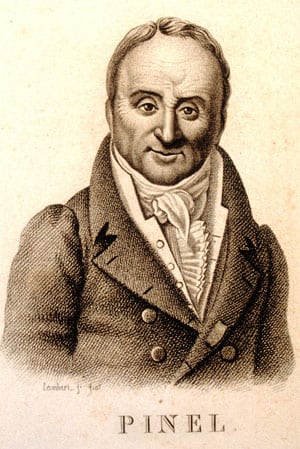
Last week I had the opportunity to give a lecture at the Lunar Society – an offshoot of the Medical History Society of New Jersey – on the campus of Rutgers University in New Brunswick. The Lunar Society is named after a British social club in the 18th century which was composed of a group of intellectuals who enjoyed exchanging ideas. According to scholar Michael Nevins in his book, Still More Meanderings in Medical History, Lunar Society members held the optimistic belief that science could dispel ignorance.
 My topic was the legacy of Philippe Pinel, a physician known for removing chains from the mentally ill in the insane asylums in Paris during the French Revolution. I became interested in Pinel in the 1990’s when my career was centered in the long-term care industry, around the time that regulations restricting physical restraints in nursing homes went into effect. My paper on Pinel appeared in the Journal of the American Geriatrics Society in 1996. I was tickled that Dr. Nevins invited me to speak to this group, and it gave me the opportunity to dust off my slides, scan them, and make a new PowerPoint. He encouraged me to title the talk, “Philippe Pinel and the French Revolution: Off with Their Chains!”
My topic was the legacy of Philippe Pinel, a physician known for removing chains from the mentally ill in the insane asylums in Paris during the French Revolution. I became interested in Pinel in the 1990’s when my career was centered in the long-term care industry, around the time that regulations restricting physical restraints in nursing homes went into effect. My paper on Pinel appeared in the Journal of the American Geriatrics Society in 1996. I was tickled that Dr. Nevins invited me to speak to this group, and it gave me the opportunity to dust off my slides, scan them, and make a new PowerPoint. He encouraged me to title the talk, “Philippe Pinel and the French Revolution: Off with Their Chains!”
I arrived early to get settled, and to my amazement the arriving guests included two of my professors from medical school at UMDNJ in Newark. Of course we did a selfie, presented above. The gentleman in the middle with the bowtie is Dr. Alan Weisse, my cardiology teacher who is credited as one of the first to perform diagnostic echocardiography in New Jersey. The man on the right is Dr. Dick Wedeen, a renowned nephrologist and gout specialist. I remember him for his medical history lectures and passion for collecting “gout stools” – an early medical technology for relieving the pain of gouty arthritis by elevating the leg. Both of them were retired from medical practice and teaching.
Before the talk I had the opportunity to schmooze and catch up with my distinguished medical mentors to whom I once presented cases in University Hospital in Newark and the East Orange VA. I was completely humbled by the opportunity to lecture to this group that included individuals who had an impact on my professional development over three decades ago.
Dr. Nevins, in his chapter on the Lunar Society, quotes a historian named Jenny Uglow who described the Lunar Society as it existed in the 17th and 18th Century:
“They formed a constellation of extraordinary individuals, a tangle of friendships and dependencies, arguments and loyalties. They were colorful, strong, idiosyncratic… the legacy of the Lunar men is with us still, in the making of the modern world and in the inspiring confidence with which all these friends, in their different ways, reached so eagerly for the moon.”
This description accurately applies to the Lunar Society that still meets 200 years later, and the distinguished men and women of medicine who attend.
* * * * * * * * * * * * * *
Dr. Nevins’ book is entitled Still More Meanderings in Medical History: The Third of a Trilogy of Meanderings in Medical History, and is published by iUniverse LLC and can be purchased here.
Related posts:
My Mentor in Geriatrics: Leslie S. Libow
Photographing at Lechworth Village
Retooling for an Aging America: The Thud that Should Have been a Bang
The complete reference for my paper is: Levine JM. J Am Geriatr Soc. 1996 Sep;44(9):1130-3. Historical notes on restraint reduction: the legacy of Dr. Philippe Pinel.
.
